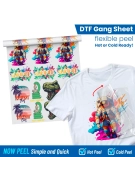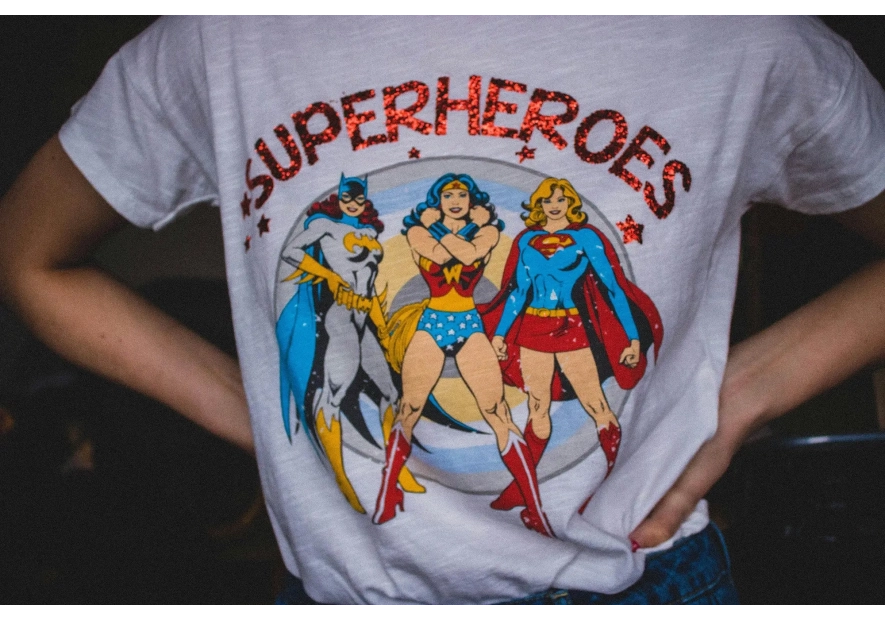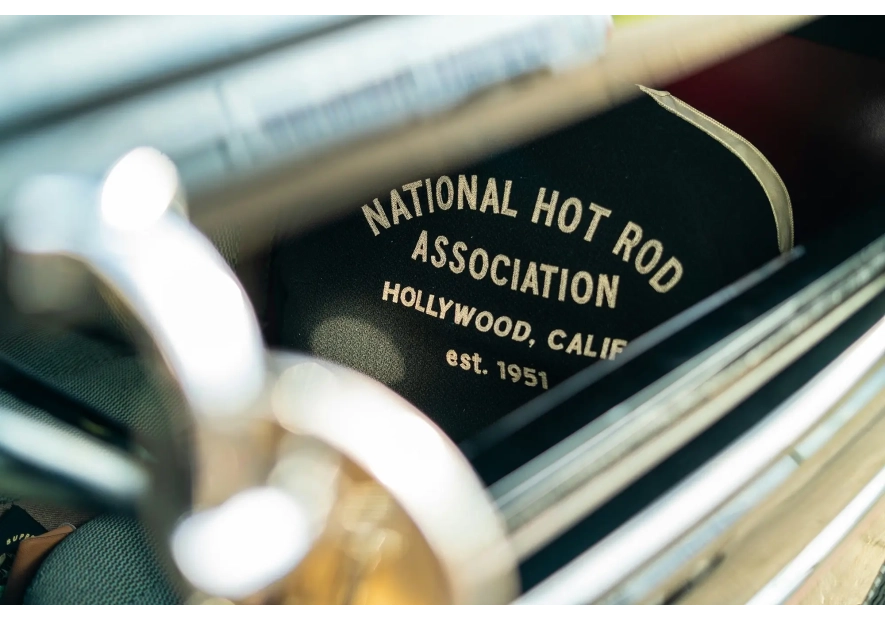How Long Do DTF Transfers Last?

You've created the perfect custom t-shirt. It's vibrant and eye-catching, but suddenly it starts fading after a few washes. This will inevitably lead you to the question, "How long do DTF transfers last?"
Today we're diving into the answer to that question, as well as other important elements to know about the world of DTF (direct-to-film) printing!
DTF Transfers
Direct-to-film (DTF) printing is a game-changer in the world of textile design. This method allows designers to print graphics onto a special film. They then transfer these designs onto various fabrics using heat.
It's a bit different from traditional printing techniques, offering more flexibility and quality in the final product.
DTF involves printing a design onto a clear film and then applying it to the fabric Unlike other methods, DTF doesn't require the fabric to absorb ink directly. This means it can work on a wide range of materials, colors, and complexities of design.
The process starts with printing a design onto a film. This film is then covered with a powder that helps the design stick to the fabric. After that, heat is applied to transfer the design from the film to the fabric. This step is important because it ensures the design is not only visible but also durable.
The beauty of DTF printing lies in its versatility. It can be used on cotton, polyester, and blends, making it ideal for a large variety of projects.
From custom t-shirts to unique fabric creations, DTF printing opens up a world of possibilities. It also allows for vibrant colors and detailed designs that stand the test of time.
Factors Influencing the Lifespan of DTF Transfers
The quality of ink and film used in DTF printing plays a big role in how long the transfers last. High-quality DTF ink is vital because it needs to stick to the film properly before it's transferred onto the fabric.
If the ink is of poor quality, it might not attach well to the film, leading to dull colors or designs that fade quickly. On the other hand, good ink ensures vibrant and lasting colors.
The film acts as a bridge between the ink and the fabric. If the film is of low quality, it might not transfer the ink onto the fabric correctly.
This can cause issues like the design not sticking well to the fabric or parts of the design missing. High-quality film ensures a smooth and complete transfer of the design, making the final product look better and last longer.
Both the ink and the film need to work well together. If one is of lower quality, it can affect the entire printing process and the durability of the design on the fabric.
Using the best materials available is a smart choice for anyone wanting to create DTF prints that stand out and stand the test of time.
Fabric Type and Compatibility
The type of fabric you choose to print on also affects how well DTF transfers will stick and how long they will last. Different fabrics react differently to heat and ink, which can change how a design looks and feels.
Cotton is a popular choice for DTF printing because it handles heat well. It also absorbs ink in a way that makes designs look sharp and vibrant.
Polyester is another good option. It works well with DTF printing, even though it's a bit trickier to work with because of its sensitivity to high temperatures. Blends of cotton and polyester can also be great, offering a balance between the two materials' benefits.
However, not all fabrics are suitable for DTF transfers. Fabrics that are too thin, delicate, or heat-sensitive might not handle the transfer process well. This could lead to designs that peel off or fade quickly. It could even damage the fabric itself.
For the best results, it's important to match the fabric's qualities with the capabilities of DTF printing to ensure your designs not only look fantastic but last as long as possible.
Factors Influencing the Lifespan of DTF Transfers
The success of DTF transfers heavily depends on the heat-pressing process. This involves using a heat press to apply the design from the film to the fabric.
The three key parameters in this step are time, temperature, and pressure. Getting these right ensures that the design not only looks good but also lasts a long time.
The temperature needs to be high enough to bond the ink to the fabric but not so high that it damages the material or the design. The exact temperature can vary depending on the type of fabric and ink used, but it's generally in a specific range that ensures optimal transfer.
The amount of time the press is applied is also important.
Too short of a time, and the ink won't transfer properly. Too long, and you risk burning the fabric or the design. Finding the perfect balance is crucial for a durable and vibrant transfer.
Pressure is the final piece of the puzzle. The heat press needs to apply enough pressure to evenly transfer the ink from the film to the fabric. Uneven pressure can lead to patches where the ink hasn't transferred properly. This affects the overall quality and durability of the design.
Post-Printing Processes
After the heat pressing is done, the DTF transfer isn't quite finished. The post-printing process, especially proper curing, plays a big part in ensuring the transfer's durability.
Curing is the process of ensuring the ink is completely dry and firmly bonded to the fabric. This might involve additional heat or time, depending on the specific ink and fabric used.
Some DTF transfers might also benefit from a post-press treatment. This could be a protective spray or another layer of heat to seal the design further. These steps help protect the design from wear and tear, making it more resistant to washing and everyday use.
Proper curing and post-printing treatments make a big difference in how long DTF transfers last. They help prevent common problems like cracking, peeling, or fading, keeping the design looking sharp and vibrant for as long as possible.
Common Wear-and-Tear Issues
Even the best DTF transfers can face issues like peeling and cracking over time. Understanding why these problems occur can help us prevent them, ensuring that our designs stay vibrant and intact for longer.
Peeling often happens when the adhesion between the transfer and the fabric isn't strong enough. This can be due to several factors, such as not using the right heat press settings or the fabric not being compatible with the transfer.
If the heat isn't applied evenly or if the pressure is too low, the ink might not bond well with the fabric. This can lead to parts of the design peeling off after a few washes or wears.
Cracking is another common problem, especially in areas of the fabric that stretch or bend a lot.
This issue is usually related to the quality of the ink and the elasticity of the transfer. Some inks become hard and brittle after curing, which means they can crack when the fabric is stretched.
Using high-quality, flexible ink can reduce this risk, but it's also important to consider the type of fabric you're printing on. Stretchy fabrics require transfers that can stretch without cracking.
Minimizing It
To minimize peeling and cracking, it's essential to follow the best practices for DTF printing. This includes choosing the right materials, using the correct heat press settings, and ensuring the fabric is suitable for the type of transfer.
Proper post-printing care, such as washing garments inside out and avoiding high heat in dryers, can also extend the life of DTF transfers.
Plus, regular checks for signs of wear and addressing any issues early can help maintain the quality of your DTF prints.
If a transfer starts to peel at the edges, a quick press with a heat press can sometimes re-adhere it to the fabric. For minor cracks, applying a fabric-safe sealant can protect the design from further damage.
Washing Instructions and Care Tips
It's important to turn the garments inside out before washing. This simple step can help protect the design from the harsh environment inside the washing machine.
Washing with cold water is also recommended. Cold water is gentler on the fabric and the transfer, reducing the risk of peeling or fading.
Using a mild detergent can make a difference too. Harsh chemicals in some detergents can damage the ink of the transfer, leading to dull colors over time.
Avoid bleach and fabric softeners as well. These products are tough on DTF transfers and can cause them to degrade quickly.
When it comes to drying, air drying is the best option. The high heat from dryers can harm the transfers, making them more likely to crack or peel. If you must use a dryer, choose a low heat setting to minimize the risk of damage.
Ironing directly on a DTF transfer is something you should avoid. If you need to iron the garment, do it inside out or place a cloth between the iron and the design. This protects the transfer from direct heat, which can melt or warp the design.
Storage and Folding
Storing your DTF-printed garments properly is also important. Keep them away from direct sunlight, which can fade the colors over time.
Folding them instead of hanging them can help prevent the fabric from stretching, which reduces the risk of cracking in the transfers.
Finally, it's wise to wash these garments separately from heavy items like jeans or jackets. Rough items can rub against the transfers during the wash cycle, leading to unnecessary wear.
By following these care tips, you can extend the life of your DTF transfers. It shows that a little attention and gentle handling can keep your custom-printed garments looking vibrant and new for a long time.
Keeping your DTF prints in top condition is all about the care you put in after the printing process.
How Long Do DTF Transfers Last?
So, now that you know all the variables, you know that there's not one answer. But the general expectation is that DTF transfers should last anywhere from 2 to 5 years, depending on the materials, the care, and more.
Enhancing the Lifespan of DTF Transfers
Using high-quality materials is essential for creating DTF transfers that stand the test of time.
This means selecting the best ink, film, and fabric you can find. High-quality ink ensures that your designs are vibrant and fade-resistant.
The right film can make a big difference in how well the design transfers and adheres to the fabric. Choosing a fabric that matches well with the ink and film can help prevent issues like peeling and cracking.
But how do you know what materials to choose?
Look for products with good reviews from other users and try them out to see how they work with your specific designs and equipment. It might take some time to find the perfect combination, but the effort is worth it when you end up with durable, high-quality transfers.
Staying up to date with the latest techniques and innovations in DTF printing can also help improve the lifespan of your transfers. The DTF printing industry is always evolving, with new advances in ink formulas, transfer films, and heat press technology.
These innovations can offer better adhesion, increased durability, and more flexibility, reducing the risk of peeling, cracking, and fading.
One way to keep up with these advances is to connect with a community of DTF printers. Online forums, social media groups, and trade shows can be great resources for learning about new products and techniques.
Long Lasting DTF Transfers
So now you understand that there are a lot of variables that affect your question, "How long do DTF transfers last?"
By focusing on high-quality inks and fabrics, and employing proper maintenance techniques, you can ensure your DTF creations not only captivate but endure through time and wear.
With DTF Transfers Wholesale, you can discover top-quality direct-to-film, DTF transfers at unbeatable wholesale prices. Benefiting from significant cost savings on bulk orders, our DTF transfers are your solution for efficient, high-volume production with stunning results. Contact us to place your bulk order and transform your printing possibilities today!
OkCancel





Leave a comment